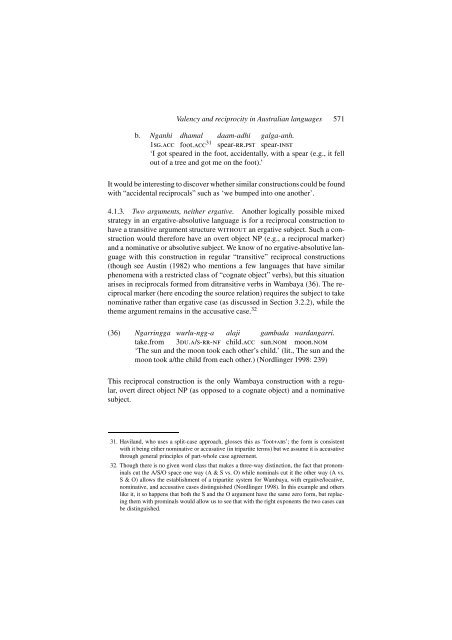Valency mismatches and the coding of reciprocity in ... - Linguistics
Valency mismatches and the coding of reciprocity in ... - Linguistics
Valency mismatches and the coding of reciprocity in ... - Linguistics
Create successful ePaper yourself
Turn your PDF publications into a flip-book with our unique Google optimized e-Paper software.
<strong>Valency</strong> <strong>and</strong> <strong>reciprocity</strong> <strong>in</strong> Australian languages 571<br />
b. Nganhi dhamal<br />
1sg.acc foot.acc31 daam-adhi galga-anh.<br />
spear-rr.pst spear-<strong>in</strong>st<br />
‘I got speared <strong>in</strong> <strong>the</strong> foot, accidentally, with a spear (e.g., it fell<br />
out <strong>of</strong> a tree <strong>and</strong> got me on <strong>the</strong> foot).’<br />
It would be <strong>in</strong>terest<strong>in</strong>g to discover whe<strong>the</strong>r similar constructions could be found<br />
with “accidental reciprocals” such as ‘we bumped <strong>in</strong>to one ano<strong>the</strong>r’.<br />
4.1.3. Two arguments, nei<strong>the</strong>r ergative. Ano<strong>the</strong>r logically possible mixed<br />
strategy <strong>in</strong> an ergative-absolutive language is for a reciprocal construction to<br />
have a transitive argument structure without an ergative subject. Such a construction<br />
would <strong>the</strong>refore have an overt object NP (e.g., a reciprocal marker)<br />
<strong>and</strong> a nom<strong>in</strong>ative or absolutive subject. We know <strong>of</strong> no ergative-absolutive language<br />
with this construction <strong>in</strong> regular “transitive” reciprocal constructions<br />
(though see Aust<strong>in</strong> (1982) who mentions a few languages that have similar<br />
phenomena with a restricted class <strong>of</strong> “cognate object” verbs), but this situation<br />
arises <strong>in</strong> reciprocals formed from ditransitive verbs <strong>in</strong> Wambaya (36). The reciprocal<br />
marker (here en<strong>cod<strong>in</strong>g</strong> <strong>the</strong> source relation) requires <strong>the</strong> subject to take<br />
nom<strong>in</strong>ative ra<strong>the</strong>r than ergative case (as discussed <strong>in</strong> Section 3.2.2), while <strong>the</strong><br />
<strong>the</strong>me argument rema<strong>in</strong>s <strong>in</strong> <strong>the</strong> accusative case. 32<br />
(36) Ngarr<strong>in</strong>gga wurlu-ngg-a alaji gambada wardangarri.<br />
take.from 3du.a/s-rr-nf child.acc sun.nom moon.nom<br />
‘The sun <strong>and</strong> <strong>the</strong> moon took each o<strong>the</strong>r’s child.’ (lit., The sun <strong>and</strong> <strong>the</strong><br />
moon took a/<strong>the</strong> child from each o<strong>the</strong>r.) (Nordl<strong>in</strong>ger 1998: 239)<br />
This reciprocal construction is <strong>the</strong> only Wambaya construction with a regular,<br />
overt direct object NP (as opposed to a cognate object) <strong>and</strong> a nom<strong>in</strong>ative<br />
subject.<br />
31. Havil<strong>and</strong>, who uses a split-case approach, glosses this as ‘foot+abs’; <strong>the</strong> form is consistent<br />
with it be<strong>in</strong>g ei<strong>the</strong>r nom<strong>in</strong>ative or accusative (<strong>in</strong> tripartite terms) but we assume it is accusative<br />
through general pr<strong>in</strong>ciples <strong>of</strong> part-whole case agreement.<br />
32. Though <strong>the</strong>re is no given word class that makes a three-way dist<strong>in</strong>ction, <strong>the</strong> fact that pronom<strong>in</strong>als<br />
cut <strong>the</strong> A/S/O space one way (A & S vs. O) while nom<strong>in</strong>als cut it <strong>the</strong> o<strong>the</strong>r way (A vs.<br />
S & O) allows <strong>the</strong> establishment <strong>of</strong> a tripartite system for Wambaya, with ergative/locative,<br />
nom<strong>in</strong>ative, <strong>and</strong> accusative cases dist<strong>in</strong>guished (Nordl<strong>in</strong>ger 1998). In this example <strong>and</strong> o<strong>the</strong>rs<br />
like it, it so happens that both <strong>the</strong> S <strong>and</strong> <strong>the</strong> O argument have <strong>the</strong> same zero form, but replac<strong>in</strong>g<br />
<strong>the</strong>m with prom<strong>in</strong>als would allow us to see that with <strong>the</strong> right exponents <strong>the</strong> two cases can<br />
be dist<strong>in</strong>guished.

















